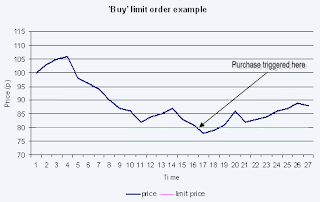A Limit Order is very different when compared to a Market Order. Unlike a Market Order, a Limit Order does not execute instantaneously nor does it choose the best available price on the market for the stock. What is the advantage of a Limit Order, then? The primary advantage of a Limit Order is that you are able to set the price at which you want to purchase the stock.
The primary advantage of a Limit Order is that you can "name your own price" for the stock that you want to purchase. This is particularly helpful for stocks that are very volatile during a trading day.
Image Source: psdgraphics.com
Assume that there is a stock, say Apple (AAPL), trading on an uptrend one day. If the stock is appreciating and you expect the stock to continue rising in price, you would want to purchase the stock at the lowest price possible so that your gains can also be greater. However, if the stock is behaving in a volatile manner (swinging up and down rather than appreciating in a smooth uptrend), it would be rather difficult to hone in on a low price as the price may change as soon as you execute the order. This would likely be the case when executing a Market Order, as the Market Order will execute immediately and take the best available price available.
So how can you safeguard your decision to purchase Apple stock while still avoiding the volatility of the stock price? The Limit Order can be the perfect stock order to help you in this situation. When setting a Limit Order, you are essentially "naming the price" at which you want to purchase the stock. For instance, if Apple was trading between $326 and $327 the moment at which you wanted to purchase the stock, and you wanted to purchase it at $325.50, you simply input the "$325.50" as the price on your Limit Order.
A Limit Order will only execute when the stock price has reached your target price. In this example, the pink line represents the target price and the blue line represents the stock price. Notice how the stock price intersects the target price, triggering the Limit Order to execute.
Image Source: selftrade.co.uk
Does this mean that you will end up purchasing Apple stock at $325? Not exactly. See, the advantage of the Limit Order is its precision in choosing price--the disadvantage on the other hand, is that that price may never be reached. So in this case, if Apple stock kept appreciating from $326 to $327 to $328 and onwards, your Limit Order will never execute because you set the price at $325.50! Thus, you would never get the stock in your hands.
However, if the price of Apple stock dipped slightly and hit $325.50, even for just a brief moment, your Limit Order will execute and you will purchase Apple stock at $325.50. From that point onwards, if Apple stock kept on going higher, you would gain more profits than you would have if you executed a Market Order and ended up purchasing Apple stock at $326 instead of $325.50.
If this is still unclear to you, think about it this way. A Limit Order is like a highlighter which highlights a specific price on an entire sheet of prices. You can only highlight one price. Suppose our sheet has every price from $325.00 to $327.00, including all of the decimals in-between. You highlighted only one price: $325.50. Now suppose that Apple stock is swinging between $326.30 and $326.20. Since the stock price hasn't gone down far enough to hit your highlighted $325.50, your stock order will not execute. However, if the stock price is very volatile and swings down and hits your $325.50, your Limit Order will execute and you will purchase Apple at exactly $325.50.
A drawback to the Limit Order is that the stock price may take some time before it reaches the target price. In fact, the stock price may never reach your target price. Thus, the Limit Order may never execute.
Image Source: mergersandinquisitions.com
The beauty of the Limit Order is that you can set up a Limit Order and leave your computer and do other activities, since you have the peace of mind knowing that the Limit Order will only purchase the stock at the price at which you specified (or better), or it will not execute at all.
Because of its precision, the Limit Order is a very popular stock order. Unlike the Market Order, a Limit Order has the ability to target a single price and purchase the stock at that price only. The disadvantage to this is that it may take a long time for the stock to hit that price--or it may never even hit that price! To avoid this, many investors use a realistic Limit Order within two decimal places. Suppose Apple is fluctuating between $325.50 and $325.75. It would be more realistic to set a Limit Order at $325.60 than it would be to set a Limit Order at $325.40, since the stock price is not moving at that low of a range yet.
Used in conjunction with the Market Order, a Limit Order can be one of the most important and essential stock orders for any investor!
Look forward to my upcoming post in this series!




No comments:
Post a Comment